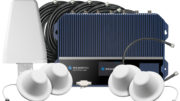What’s in a name? Not much really, as William Shakespeare once said. It’s pretty common to call a cell booster an amplifier, but it’s not really the best description of everything it does. It’s like calling your cell phone a clock — sure it does that, but it does so much more.
Let’s start with what an amplifier is.
An amplifier takes an incoming signal and makes it stronger. There are analog ones and digital ones and some of them add a lot of noise to the signal and some don’t… but at the end of the day all amplifiers take a weaker signal and turn it into a stronger one. And in truth, a cell booster does that as well. It also does quite a few other things as well.
How is a cell booster different from that?
For starters, a cell booster is a two-way device. It not only amplifies the signal coming from a nearby tower, but it also amplifies the signal coming from your cell phone going back to that tower. After all, it’s not very useful to listen if you can’t speak. There’s a constant three-way stream of communication between your phone, the tower, and the booster, and it’s all happening in real time, intelligently, and so well that you can’t even tell it’s happening at all. Not only that, but your cell booster doesn’t just help you; a cell booster handles many calls (or data streams) at the same time and it knows how to keep them separate. That’s some pretty impressive stuff there.
Taking weak signal and turning it into a strong one can be a disaster if you do it wrong. Ask anyone who has ever stood in front of a microphone; turn that volume knob way up and you’ll get a screeching feedback sound. As annoying as that is to hear, it’s nowhere near as disastrous as a similar situation in a cell booster. The early days of cell boosters saw low-priced products actually burn out cell towers by causing feedback on the line. Today’s cell boosters have powerful antifeedback circuitry that is constantly monitoring the power going through the system and shutting down (or scaling back) if the power level is too high. That’s not only a helpful feature, it’s also required by the FCC.
A few more things you might want to know
While most cell boosters are designed to help multiple phones communicate with a tower, there are others that are designed to help phones communicate with each other. Called mobile-to-mobile (M2M) boosters, they boost data signals between phones making it possible to do more locally and spend less time communicating with a distant tower. These are far less common today now that most phones have powerful LTE radios but it’s just one way that a cell booster is more than just an amplifier.
Oh, and just one more thing– FCC regulations require that all cell boosters be sold with everything you need and that includes the antennas and cable. So, even if we were to talk about the central part of a system as an amplifier, there’s just a lot more stuff in the box and that’s a good thing.
So, folks, call it a cell amplifier if you wish; after all it’s just a piece of gear and doesn’t have feelings. But do remember that you’re not giving this little box the credit it deserves!





